TAX 12 Assignment: Analysis of Tax Laws on Income and Benefits
VerifiedAdded on 2021/05/31
|14
|1954
|20
Homework Assignment
AI Summary
This assignment analyzes a company's tax situation, focusing on ordinary income, capital gains, and fringe benefits. The company, involved in renovations and property leasing, generated income from rents (ordinary income) and asset sales (statutory income). The analysis examines relevant tax laws, including those related to capital assets and statutory income. The assignment then delves into fringe benefit tax calculations, including car fringe benefits, loan fringe benefits, and property fringe benefits. Calculations are provided for each type of benefit, determining taxable values and the overall fringe benefit tax amount. The assignment also includes references to relevant tax literature.
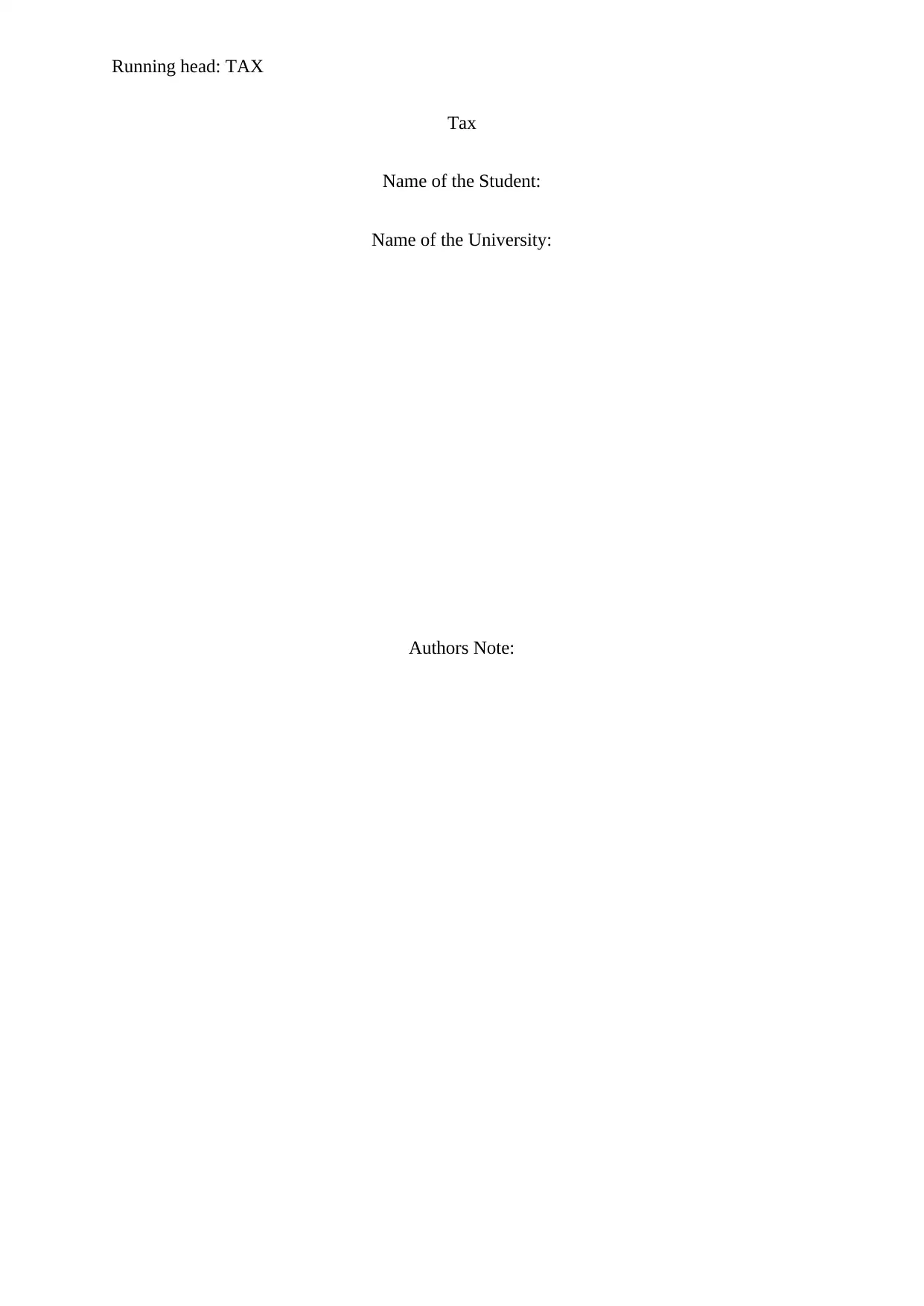
Running head: TAX
Tax
Name of the Student:
Name of the University:
Authors Note:
Tax
Name of the Student:
Name of the University:
Authors Note:
Paraphrase This Document
Need a fresh take? Get an instant paraphrase of this document with our AI Paraphraser
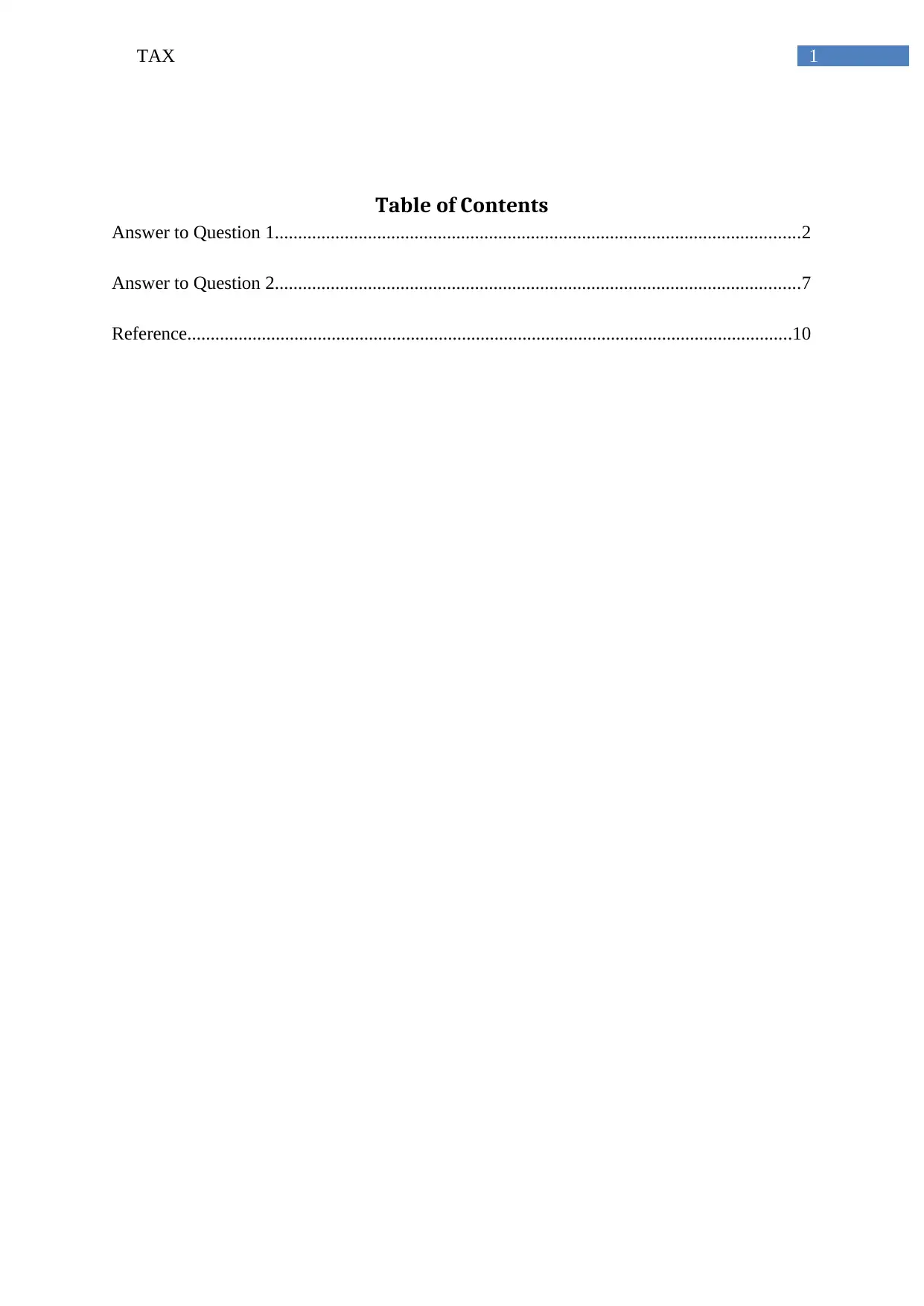
1TAX
Table of Contents
Answer to Question 1.................................................................................................................2
Answer to Question 2.................................................................................................................7
Reference..................................................................................................................................10
Table of Contents
Answer to Question 1.................................................................................................................2
Answer to Question 2.................................................................................................................7
Reference..................................................................................................................................10
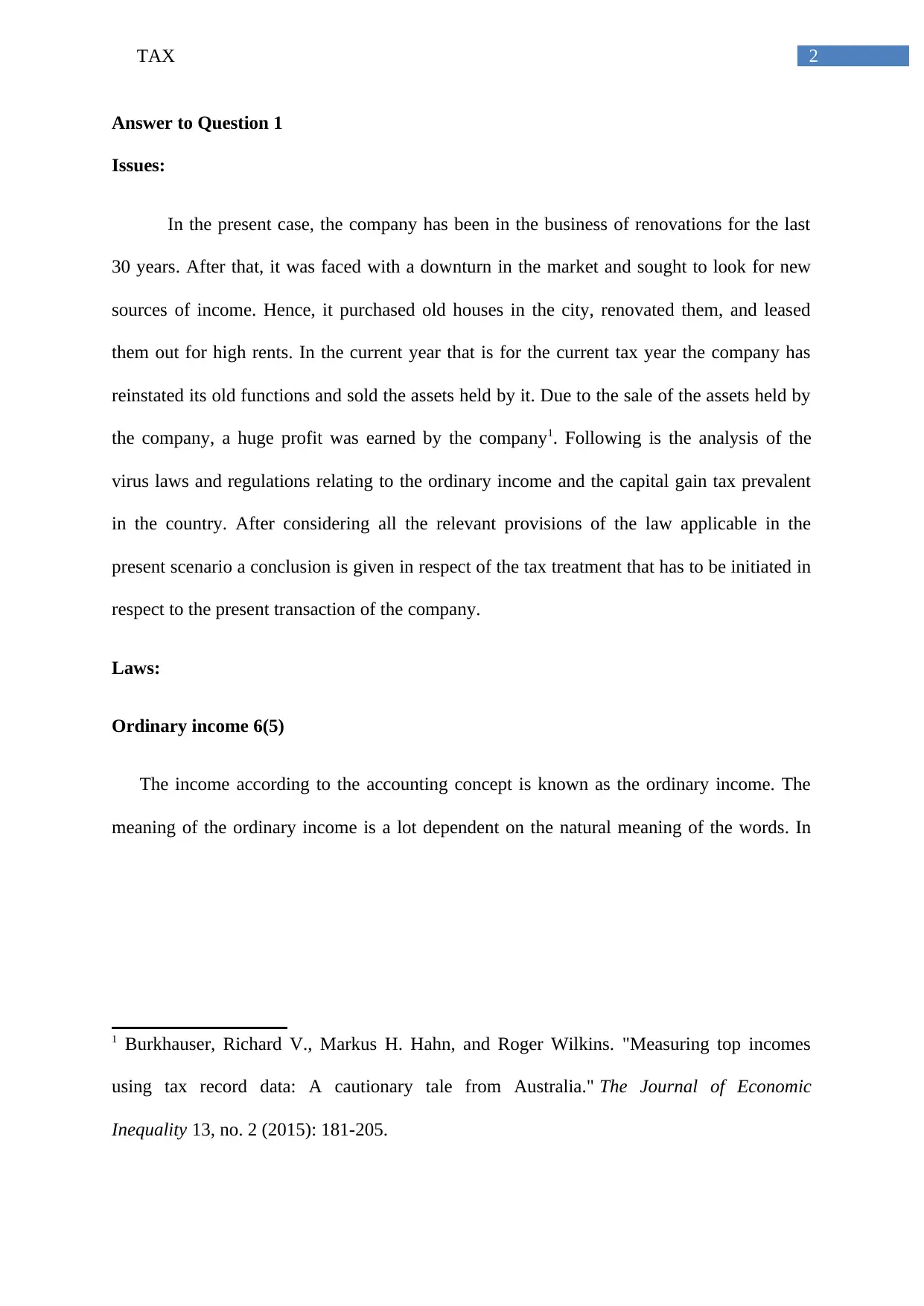
2TAX
Answer to Question 1
Issues:
In the present case, the company has been in the business of renovations for the last
30 years. After that, it was faced with a downturn in the market and sought to look for new
sources of income. Hence, it purchased old houses in the city, renovated them, and leased
them out for high rents. In the current year that is for the current tax year the company has
reinstated its old functions and sold the assets held by it. Due to the sale of the assets held by
the company, a huge profit was earned by the company1. Following is the analysis of the
virus laws and regulations relating to the ordinary income and the capital gain tax prevalent
in the country. After considering all the relevant provisions of the law applicable in the
present scenario a conclusion is given in respect of the tax treatment that has to be initiated in
respect to the present transaction of the company.
Laws:
Ordinary income 6(5)
The income according to the accounting concept is known as the ordinary income. The
meaning of the ordinary income is a lot dependent on the natural meaning of the words. In
1 Burkhauser, Richard V., Markus H. Hahn, and Roger Wilkins. "Measuring top incomes
using tax record data: A cautionary tale from Australia." The Journal of Economic
Inequality 13, no. 2 (2015): 181-205.
Answer to Question 1
Issues:
In the present case, the company has been in the business of renovations for the last
30 years. After that, it was faced with a downturn in the market and sought to look for new
sources of income. Hence, it purchased old houses in the city, renovated them, and leased
them out for high rents. In the current year that is for the current tax year the company has
reinstated its old functions and sold the assets held by it. Due to the sale of the assets held by
the company, a huge profit was earned by the company1. Following is the analysis of the
virus laws and regulations relating to the ordinary income and the capital gain tax prevalent
in the country. After considering all the relevant provisions of the law applicable in the
present scenario a conclusion is given in respect of the tax treatment that has to be initiated in
respect to the present transaction of the company.
Laws:
Ordinary income 6(5)
The income according to the accounting concept is known as the ordinary income. The
meaning of the ordinary income is a lot dependent on the natural meaning of the words. In
1 Burkhauser, Richard V., Markus H. Hahn, and Roger Wilkins. "Measuring top incomes
using tax record data: A cautionary tale from Australia." The Journal of Economic
Inequality 13, no. 2 (2015): 181-205.
⊘ This is a preview!⊘
Do you want full access?
Subscribe today to unlock all pages.

Trusted by 1+ million students worldwide
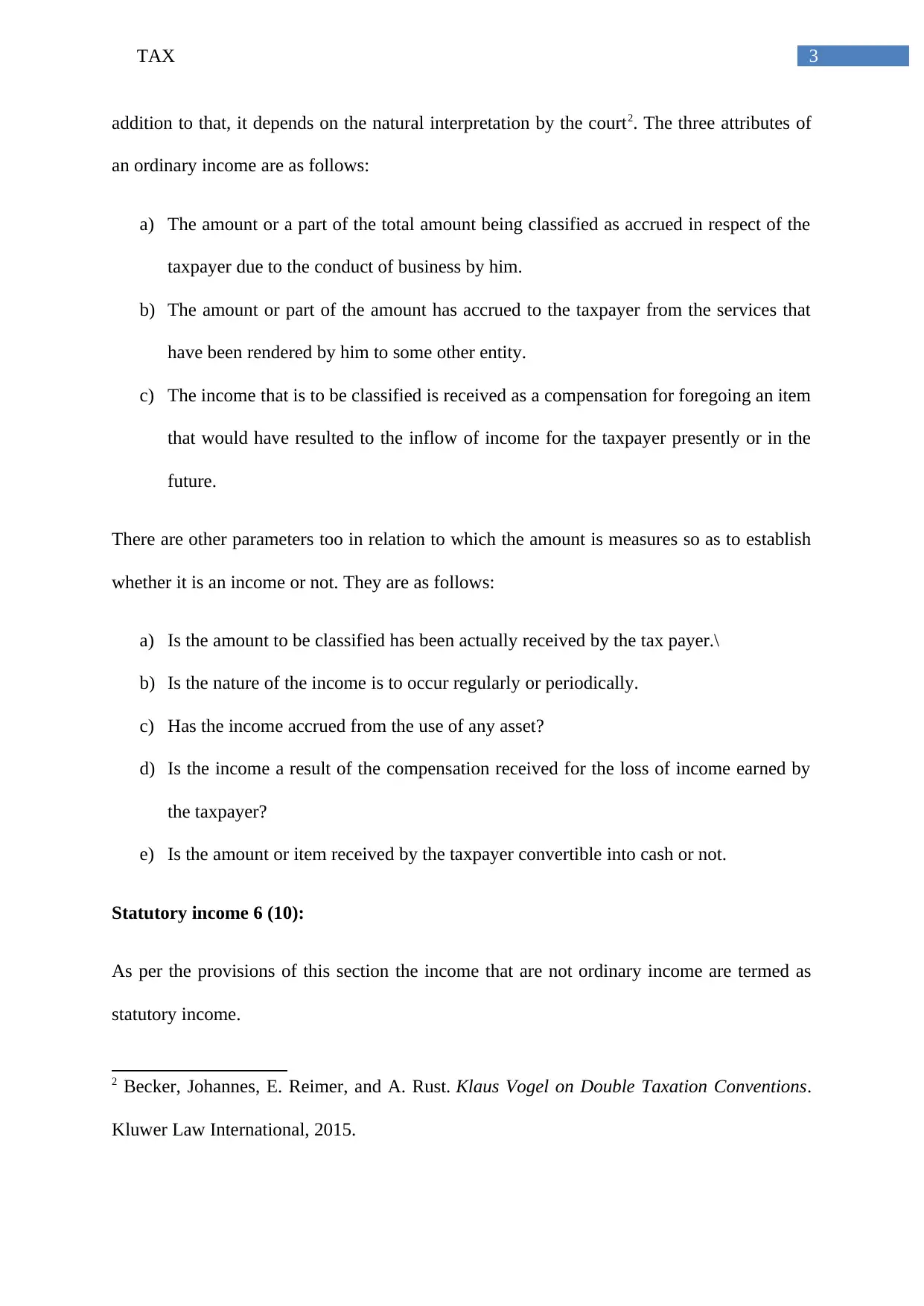
3TAX
addition to that, it depends on the natural interpretation by the court2. The three attributes of
an ordinary income are as follows:
a) The amount or a part of the total amount being classified as accrued in respect of the
taxpayer due to the conduct of business by him.
b) The amount or part of the amount has accrued to the taxpayer from the services that
have been rendered by him to some other entity.
c) The income that is to be classified is received as a compensation for foregoing an item
that would have resulted to the inflow of income for the taxpayer presently or in the
future.
There are other parameters too in relation to which the amount is measures so as to establish
whether it is an income or not. They are as follows:
a) Is the amount to be classified has been actually received by the tax payer.\
b) Is the nature of the income is to occur regularly or periodically.
c) Has the income accrued from the use of any asset?
d) Is the income a result of the compensation received for the loss of income earned by
the taxpayer?
e) Is the amount or item received by the taxpayer convertible into cash or not.
Statutory income 6 (10):
As per the provisions of this section the income that are not ordinary income are termed as
statutory income.
2 Becker, Johannes, E. Reimer, and A. Rust. Klaus Vogel on Double Taxation Conventions.
Kluwer Law International, 2015.
addition to that, it depends on the natural interpretation by the court2. The three attributes of
an ordinary income are as follows:
a) The amount or a part of the total amount being classified as accrued in respect of the
taxpayer due to the conduct of business by him.
b) The amount or part of the amount has accrued to the taxpayer from the services that
have been rendered by him to some other entity.
c) The income that is to be classified is received as a compensation for foregoing an item
that would have resulted to the inflow of income for the taxpayer presently or in the
future.
There are other parameters too in relation to which the amount is measures so as to establish
whether it is an income or not. They are as follows:
a) Is the amount to be classified has been actually received by the tax payer.\
b) Is the nature of the income is to occur regularly or periodically.
c) Has the income accrued from the use of any asset?
d) Is the income a result of the compensation received for the loss of income earned by
the taxpayer?
e) Is the amount or item received by the taxpayer convertible into cash or not.
Statutory income 6 (10):
As per the provisions of this section the income that are not ordinary income are termed as
statutory income.
2 Becker, Johannes, E. Reimer, and A. Rust. Klaus Vogel on Double Taxation Conventions.
Kluwer Law International, 2015.
Paraphrase This Document
Need a fresh take? Get an instant paraphrase of this document with our AI Paraphraser
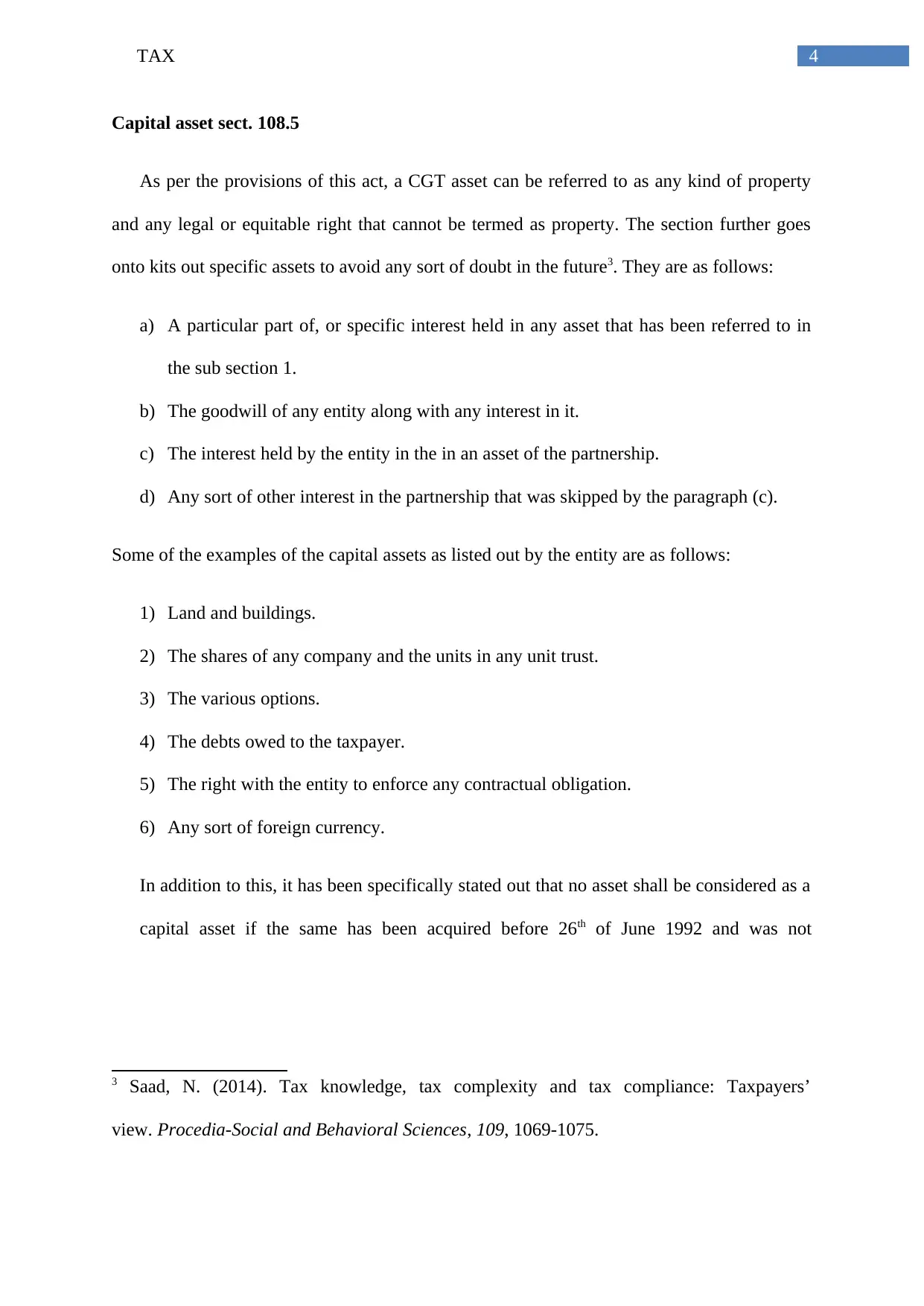
4TAX
Capital asset sect. 108.5
As per the provisions of this act, a CGT asset can be referred to as any kind of property
and any legal or equitable right that cannot be termed as property. The section further goes
onto kits out specific assets to avoid any sort of doubt in the future3. They are as follows:
a) A particular part of, or specific interest held in any asset that has been referred to in
the sub section 1.
b) The goodwill of any entity along with any interest in it.
c) The interest held by the entity in the in an asset of the partnership.
d) Any sort of other interest in the partnership that was skipped by the paragraph (c).
Some of the examples of the capital assets as listed out by the entity are as follows:
1) Land and buildings.
2) The shares of any company and the units in any unit trust.
3) The various options.
4) The debts owed to the taxpayer.
5) The right with the entity to enforce any contractual obligation.
6) Any sort of foreign currency.
In addition to this, it has been specifically stated out that no asset shall be considered as a
capital asset if the same has been acquired before 26th of June 1992 and was not
3 Saad, N. (2014). Tax knowledge, tax complexity and tax compliance: Taxpayers’
view. Procedia-Social and Behavioral Sciences, 109, 1069-1075.
Capital asset sect. 108.5
As per the provisions of this act, a CGT asset can be referred to as any kind of property
and any legal or equitable right that cannot be termed as property. The section further goes
onto kits out specific assets to avoid any sort of doubt in the future3. They are as follows:
a) A particular part of, or specific interest held in any asset that has been referred to in
the sub section 1.
b) The goodwill of any entity along with any interest in it.
c) The interest held by the entity in the in an asset of the partnership.
d) Any sort of other interest in the partnership that was skipped by the paragraph (c).
Some of the examples of the capital assets as listed out by the entity are as follows:
1) Land and buildings.
2) The shares of any company and the units in any unit trust.
3) The various options.
4) The debts owed to the taxpayer.
5) The right with the entity to enforce any contractual obligation.
6) Any sort of foreign currency.
In addition to this, it has been specifically stated out that no asset shall be considered as a
capital asset if the same has been acquired before 26th of June 1992 and was not
3 Saad, N. (2014). Tax knowledge, tax complexity and tax compliance: Taxpayers’
view. Procedia-Social and Behavioral Sciences, 109, 1069-1075.
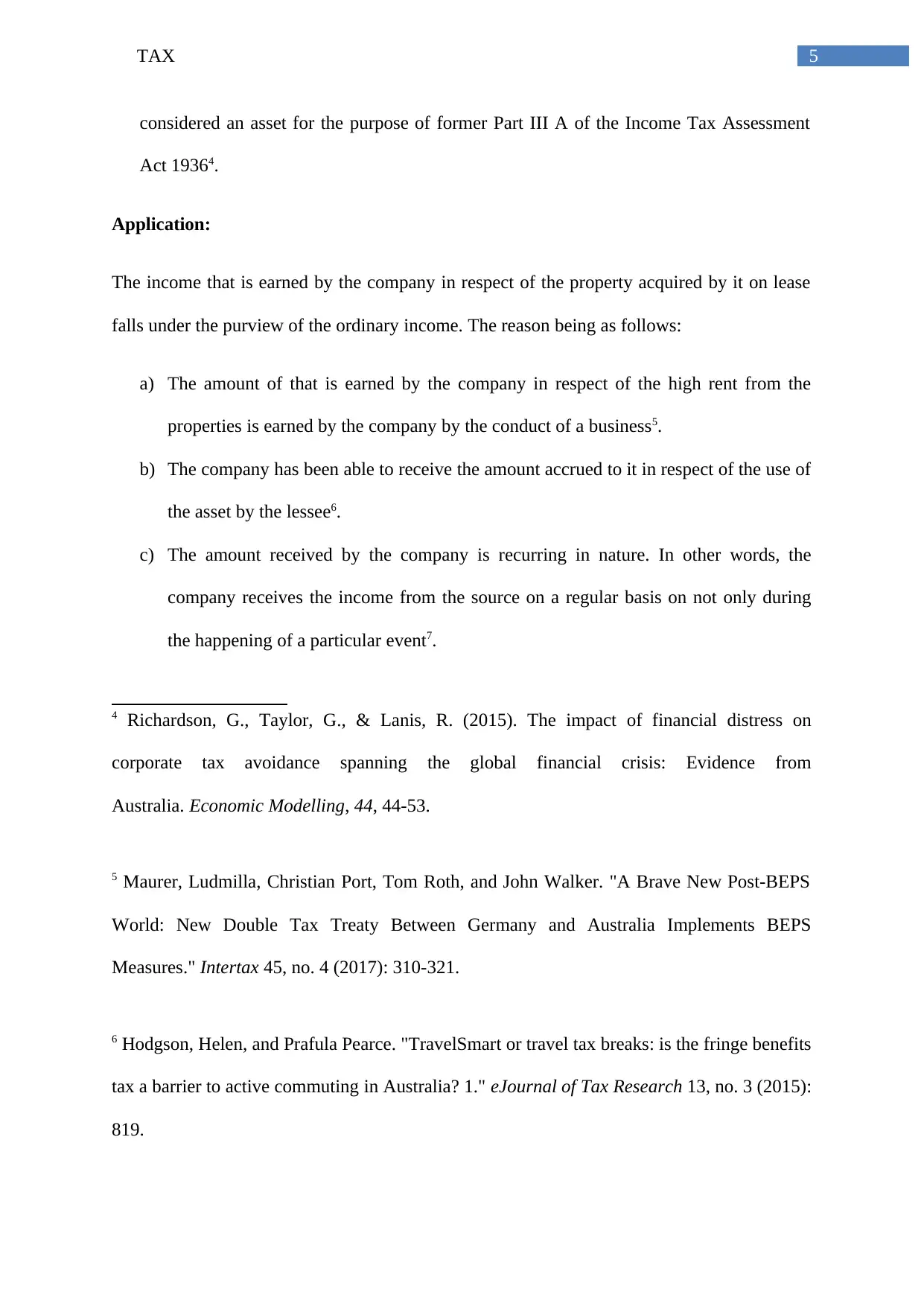
5TAX
considered an asset for the purpose of former Part III A of the Income Tax Assessment
Act 19364.
Application:
The income that is earned by the company in respect of the property acquired by it on lease
falls under the purview of the ordinary income. The reason being as follows:
a) The amount of that is earned by the company in respect of the high rent from the
properties is earned by the company by the conduct of a business5.
b) The company has been able to receive the amount accrued to it in respect of the use of
the asset by the lessee6.
c) The amount received by the company is recurring in nature. In other words, the
company receives the income from the source on a regular basis on not only during
the happening of a particular event7.
4 Richardson, G., Taylor, G., & Lanis, R. (2015). The impact of financial distress on
corporate tax avoidance spanning the global financial crisis: Evidence from
Australia. Economic Modelling, 44, 44-53.
5 Maurer, Ludmilla, Christian Port, Tom Roth, and John Walker. "A Brave New Post-BEPS
World: New Double Tax Treaty Between Germany and Australia Implements BEPS
Measures." Intertax 45, no. 4 (2017): 310-321.
6 Hodgson, Helen, and Prafula Pearce. "TravelSmart or travel tax breaks: is the fringe benefits
tax a barrier to active commuting in Australia? 1." eJournal of Tax Research 13, no. 3 (2015):
819.
considered an asset for the purpose of former Part III A of the Income Tax Assessment
Act 19364.
Application:
The income that is earned by the company in respect of the property acquired by it on lease
falls under the purview of the ordinary income. The reason being as follows:
a) The amount of that is earned by the company in respect of the high rent from the
properties is earned by the company by the conduct of a business5.
b) The company has been able to receive the amount accrued to it in respect of the use of
the asset by the lessee6.
c) The amount received by the company is recurring in nature. In other words, the
company receives the income from the source on a regular basis on not only during
the happening of a particular event7.
4 Richardson, G., Taylor, G., & Lanis, R. (2015). The impact of financial distress on
corporate tax avoidance spanning the global financial crisis: Evidence from
Australia. Economic Modelling, 44, 44-53.
5 Maurer, Ludmilla, Christian Port, Tom Roth, and John Walker. "A Brave New Post-BEPS
World: New Double Tax Treaty Between Germany and Australia Implements BEPS
Measures." Intertax 45, no. 4 (2017): 310-321.
6 Hodgson, Helen, and Prafula Pearce. "TravelSmart or travel tax breaks: is the fringe benefits
tax a barrier to active commuting in Australia? 1." eJournal of Tax Research 13, no. 3 (2015):
819.
⊘ This is a preview!⊘
Do you want full access?
Subscribe today to unlock all pages.

Trusted by 1+ million students worldwide
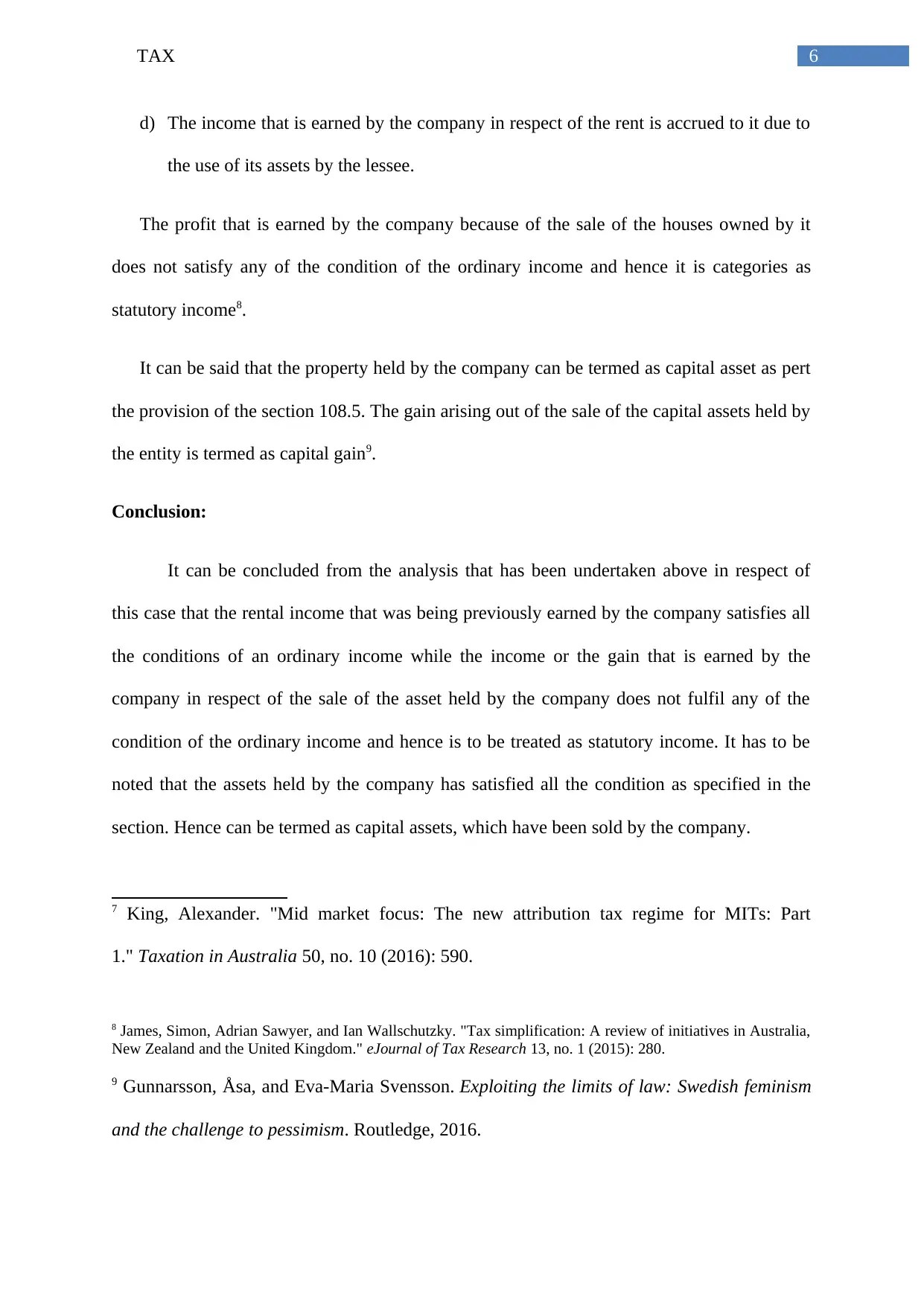
6TAX
d) The income that is earned by the company in respect of the rent is accrued to it due to
the use of its assets by the lessee.
The profit that is earned by the company because of the sale of the houses owned by it
does not satisfy any of the condition of the ordinary income and hence it is categories as
statutory income8.
It can be said that the property held by the company can be termed as capital asset as pert
the provision of the section 108.5. The gain arising out of the sale of the capital assets held by
the entity is termed as capital gain9.
Conclusion:
It can be concluded from the analysis that has been undertaken above in respect of
this case that the rental income that was being previously earned by the company satisfies all
the conditions of an ordinary income while the income or the gain that is earned by the
company in respect of the sale of the asset held by the company does not fulfil any of the
condition of the ordinary income and hence is to be treated as statutory income. It has to be
noted that the assets held by the company has satisfied all the condition as specified in the
section. Hence can be termed as capital assets, which have been sold by the company.
7 King, Alexander. "Mid market focus: The new attribution tax regime for MITs: Part
1." Taxation in Australia 50, no. 10 (2016): 590.
8 James, Simon, Adrian Sawyer, and Ian Wallschutzky. "Tax simplification: A review of initiatives in Australia,
New Zealand and the United Kingdom." eJournal of Tax Research 13, no. 1 (2015): 280.
9 Gunnarsson, Åsa, and Eva-Maria Svensson. Exploiting the limits of law: Swedish feminism
and the challenge to pessimism. Routledge, 2016.
d) The income that is earned by the company in respect of the rent is accrued to it due to
the use of its assets by the lessee.
The profit that is earned by the company because of the sale of the houses owned by it
does not satisfy any of the condition of the ordinary income and hence it is categories as
statutory income8.
It can be said that the property held by the company can be termed as capital asset as pert
the provision of the section 108.5. The gain arising out of the sale of the capital assets held by
the entity is termed as capital gain9.
Conclusion:
It can be concluded from the analysis that has been undertaken above in respect of
this case that the rental income that was being previously earned by the company satisfies all
the conditions of an ordinary income while the income or the gain that is earned by the
company in respect of the sale of the asset held by the company does not fulfil any of the
condition of the ordinary income and hence is to be treated as statutory income. It has to be
noted that the assets held by the company has satisfied all the condition as specified in the
section. Hence can be termed as capital assets, which have been sold by the company.
7 King, Alexander. "Mid market focus: The new attribution tax regime for MITs: Part
1." Taxation in Australia 50, no. 10 (2016): 590.
8 James, Simon, Adrian Sawyer, and Ian Wallschutzky. "Tax simplification: A review of initiatives in Australia,
New Zealand and the United Kingdom." eJournal of Tax Research 13, no. 1 (2015): 280.
9 Gunnarsson, Åsa, and Eva-Maria Svensson. Exploiting the limits of law: Swedish feminism
and the challenge to pessimism. Routledge, 2016.
Paraphrase This Document
Need a fresh take? Get an instant paraphrase of this document with our AI Paraphraser
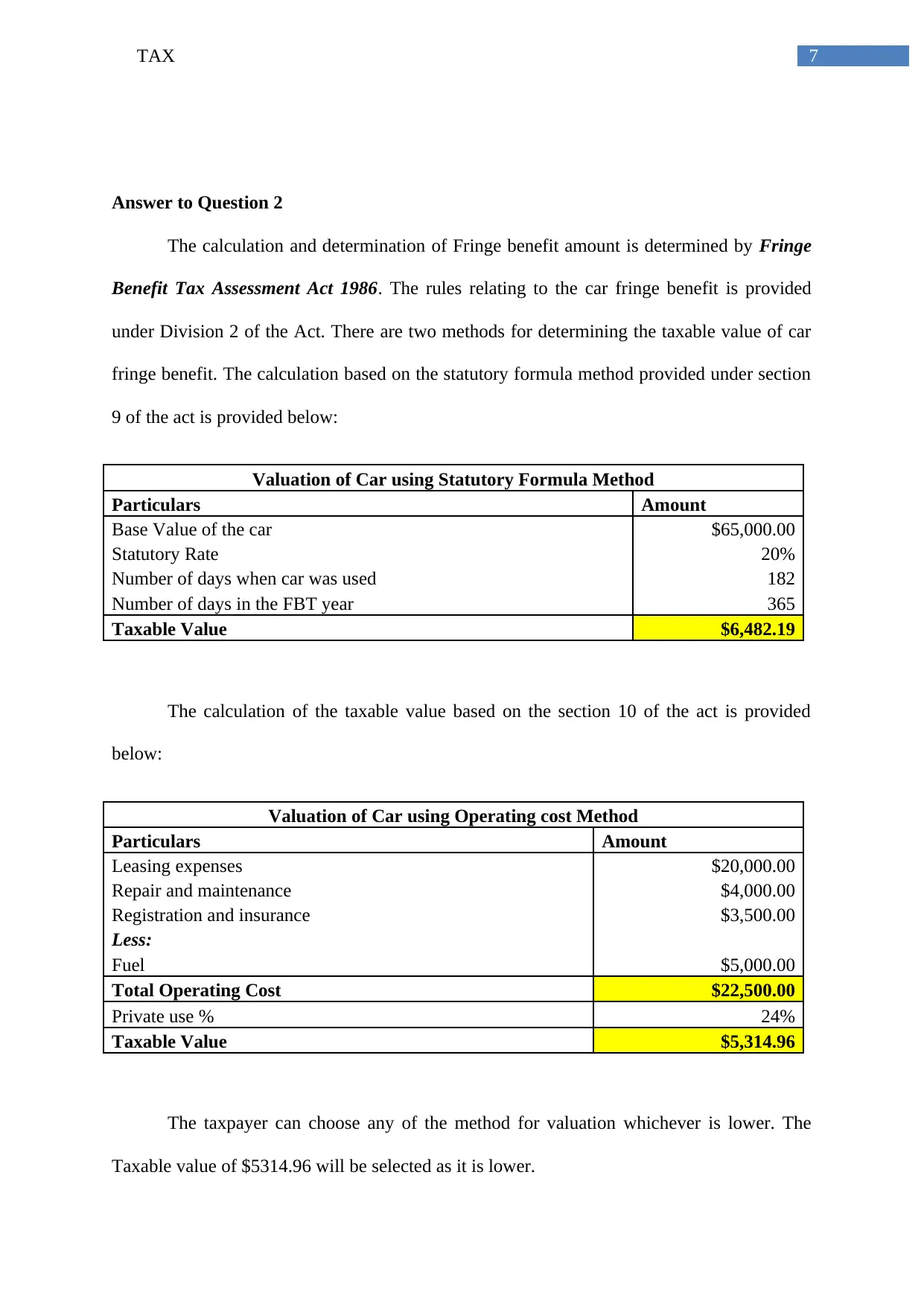
7TAX
Answer to Question 2
The calculation and determination of Fringe benefit amount is determined by Fringe
Benefit Tax Assessment Act 1986. The rules relating to the car fringe benefit is provided
under Division 2 of the Act. There are two methods for determining the taxable value of car
fringe benefit. The calculation based on the statutory formula method provided under section
9 of the act is provided below:
Valuation of Car using Statutory Formula Method
Particulars Amount
Base Value of the car $65,000.00
Statutory Rate 20%
Number of days when car was used 182
Number of days in the FBT year 365
Taxable Value $6,482.19
The calculation of the taxable value based on the section 10 of the act is provided
below:
Valuation of Car using Operating cost Method
Particulars Amount
Leasing expenses $20,000.00
Repair and maintenance $4,000.00
Registration and insurance $3,500.00
Less:
Fuel $5,000.00
Total Operating Cost $22,500.00
Private use % 24%
Taxable Value $5,314.96
The taxpayer can choose any of the method for valuation whichever is lower. The
Taxable value of $5314.96 will be selected as it is lower.
Answer to Question 2
The calculation and determination of Fringe benefit amount is determined by Fringe
Benefit Tax Assessment Act 1986. The rules relating to the car fringe benefit is provided
under Division 2 of the Act. There are two methods for determining the taxable value of car
fringe benefit. The calculation based on the statutory formula method provided under section
9 of the act is provided below:
Valuation of Car using Statutory Formula Method
Particulars Amount
Base Value of the car $65,000.00
Statutory Rate 20%
Number of days when car was used 182
Number of days in the FBT year 365
Taxable Value $6,482.19
The calculation of the taxable value based on the section 10 of the act is provided
below:
Valuation of Car using Operating cost Method
Particulars Amount
Leasing expenses $20,000.00
Repair and maintenance $4,000.00
Registration and insurance $3,500.00
Less:
Fuel $5,000.00
Total Operating Cost $22,500.00
Private use % 24%
Taxable Value $5,314.96
The taxpayer can choose any of the method for valuation whichever is lower. The
Taxable value of $5314.96 will be selected as it is lower.
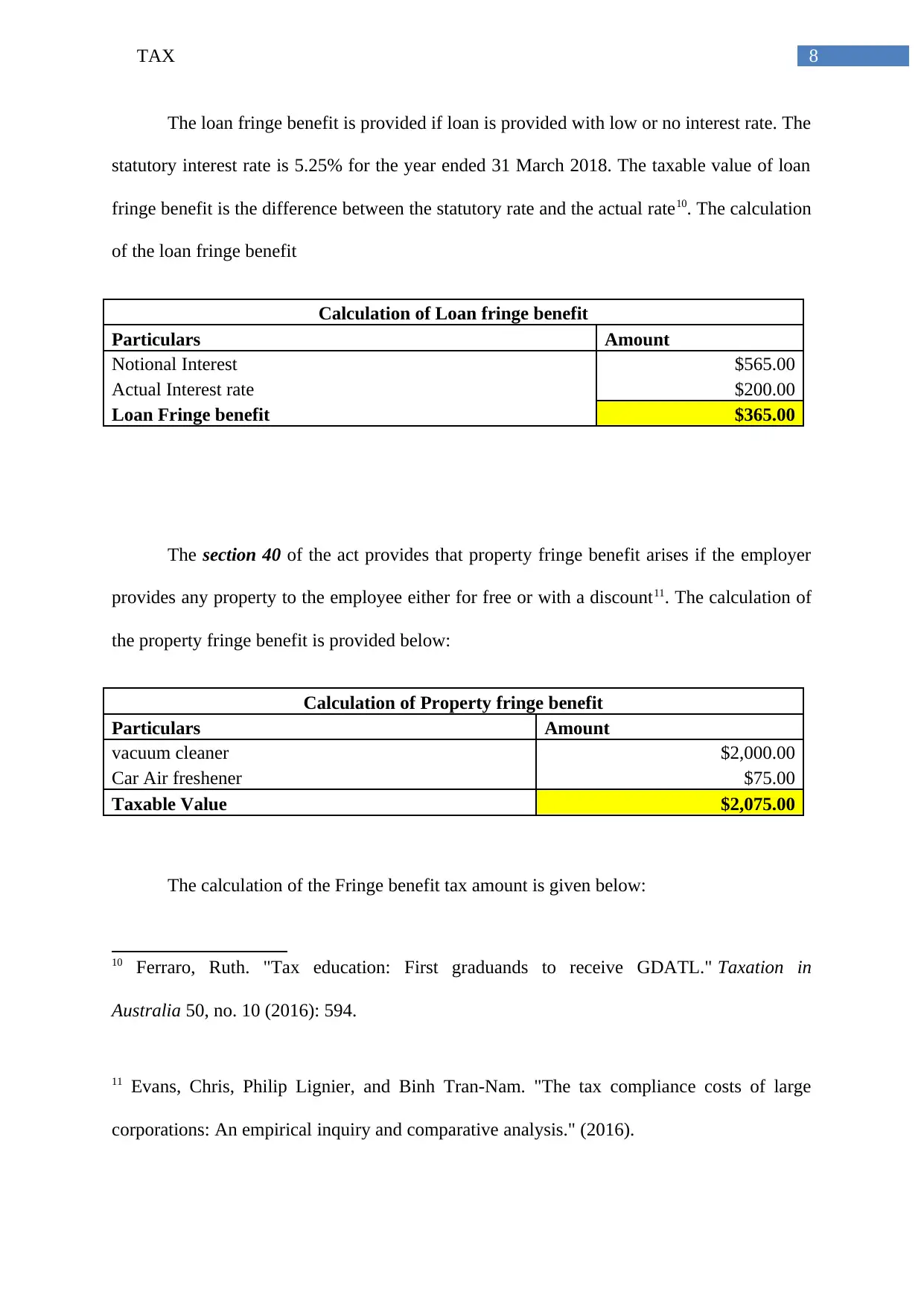
8TAX
The loan fringe benefit is provided if loan is provided with low or no interest rate. The
statutory interest rate is 5.25% for the year ended 31 March 2018. The taxable value of loan
fringe benefit is the difference between the statutory rate and the actual rate10. The calculation
of the loan fringe benefit
Calculation of Loan fringe benefit
Particulars Amount
Notional Interest $565.00
Actual Interest rate $200.00
Loan Fringe benefit $365.00
The section 40 of the act provides that property fringe benefit arises if the employer
provides any property to the employee either for free or with a discount11. The calculation of
the property fringe benefit is provided below:
Calculation of Property fringe benefit
Particulars Amount
vacuum cleaner $2,000.00
Car Air freshener $75.00
Taxable Value $2,075.00
The calculation of the Fringe benefit tax amount is given below:
10 Ferraro, Ruth. "Tax education: First graduands to receive GDATL." Taxation in
Australia 50, no. 10 (2016): 594.
11 Evans, Chris, Philip Lignier, and Binh Tran-Nam. "The tax compliance costs of large
corporations: An empirical inquiry and comparative analysis." (2016).
The loan fringe benefit is provided if loan is provided with low or no interest rate. The
statutory interest rate is 5.25% for the year ended 31 March 2018. The taxable value of loan
fringe benefit is the difference between the statutory rate and the actual rate10. The calculation
of the loan fringe benefit
Calculation of Loan fringe benefit
Particulars Amount
Notional Interest $565.00
Actual Interest rate $200.00
Loan Fringe benefit $365.00
The section 40 of the act provides that property fringe benefit arises if the employer
provides any property to the employee either for free or with a discount11. The calculation of
the property fringe benefit is provided below:
Calculation of Property fringe benefit
Particulars Amount
vacuum cleaner $2,000.00
Car Air freshener $75.00
Taxable Value $2,075.00
The calculation of the Fringe benefit tax amount is given below:
10 Ferraro, Ruth. "Tax education: First graduands to receive GDATL." Taxation in
Australia 50, no. 10 (2016): 594.
11 Evans, Chris, Philip Lignier, and Binh Tran-Nam. "The tax compliance costs of large
corporations: An empirical inquiry and comparative analysis." (2016).
⊘ This is a preview!⊘
Do you want full access?
Subscribe today to unlock all pages.

Trusted by 1+ million students worldwide
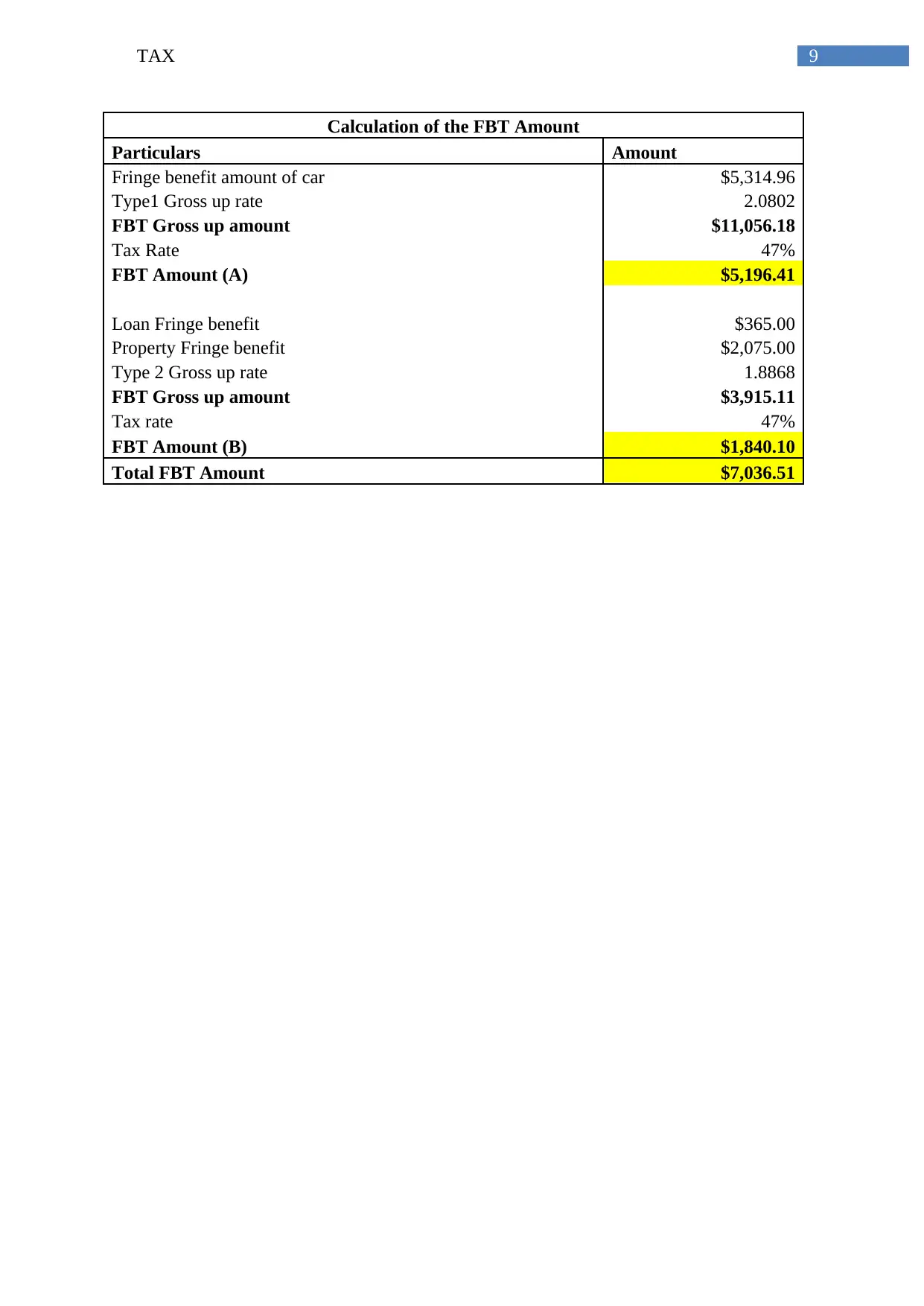
9TAX
Calculation of the FBT Amount
Particulars Amount
Fringe benefit amount of car $5,314.96
Type1 Gross up rate 2.0802
FBT Gross up amount $11,056.18
Tax Rate 47%
FBT Amount (A) $5,196.41
Loan Fringe benefit $365.00
Property Fringe benefit $2,075.00
Type 2 Gross up rate 1.8868
FBT Gross up amount $3,915.11
Tax rate 47%
FBT Amount (B) $1,840.10
Total FBT Amount $7,036.51
Calculation of the FBT Amount
Particulars Amount
Fringe benefit amount of car $5,314.96
Type1 Gross up rate 2.0802
FBT Gross up amount $11,056.18
Tax Rate 47%
FBT Amount (A) $5,196.41
Loan Fringe benefit $365.00
Property Fringe benefit $2,075.00
Type 2 Gross up rate 1.8868
FBT Gross up amount $3,915.11
Tax rate 47%
FBT Amount (B) $1,840.10
Total FBT Amount $7,036.51
Paraphrase This Document
Need a fresh take? Get an instant paraphrase of this document with our AI Paraphraser
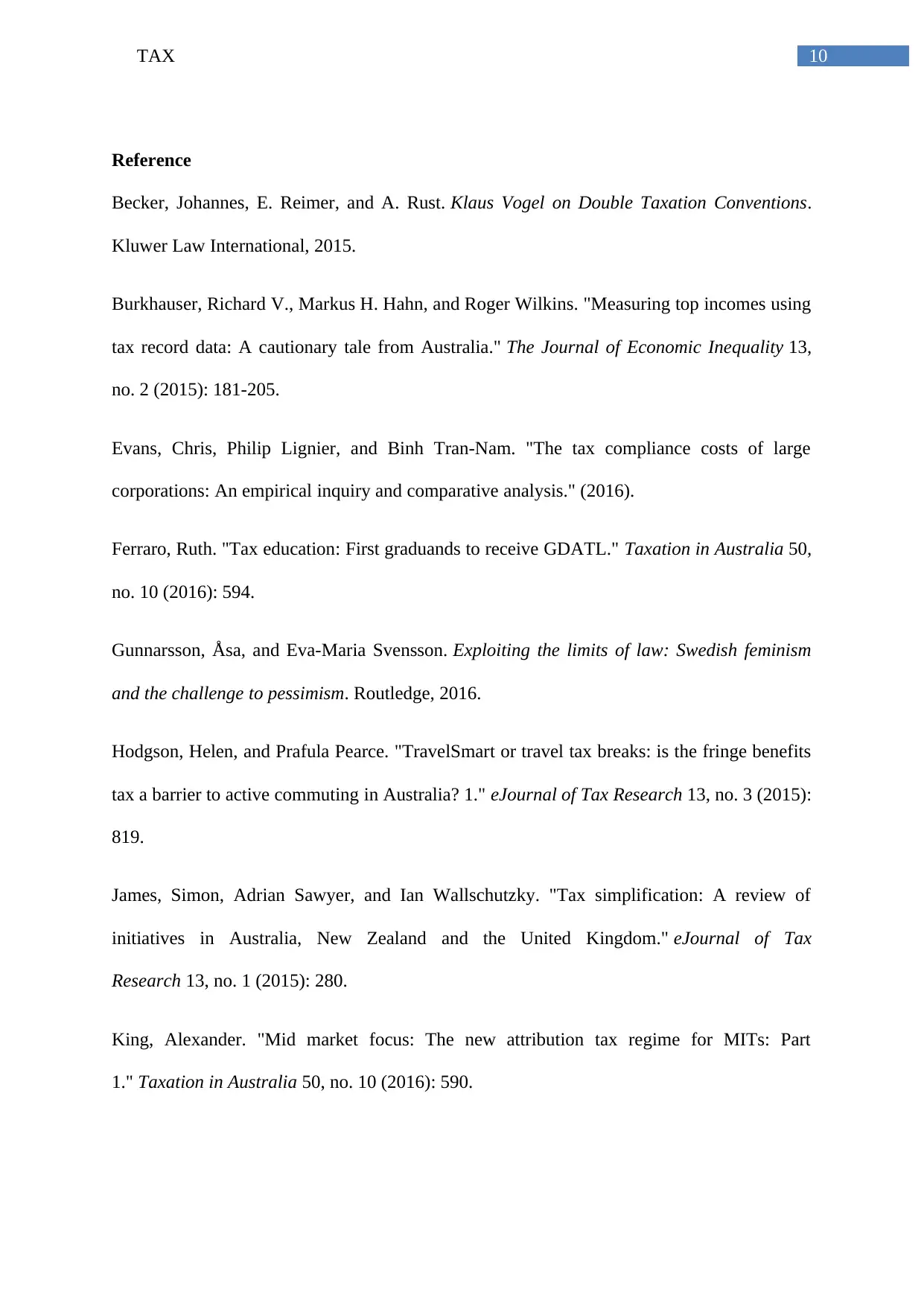
10TAX
Reference
Becker, Johannes, E. Reimer, and A. Rust. Klaus Vogel on Double Taxation Conventions.
Kluwer Law International, 2015.
Burkhauser, Richard V., Markus H. Hahn, and Roger Wilkins. "Measuring top incomes using
tax record data: A cautionary tale from Australia." The Journal of Economic Inequality 13,
no. 2 (2015): 181-205.
Evans, Chris, Philip Lignier, and Binh Tran-Nam. "The tax compliance costs of large
corporations: An empirical inquiry and comparative analysis." (2016).
Ferraro, Ruth. "Tax education: First graduands to receive GDATL." Taxation in Australia 50,
no. 10 (2016): 594.
Gunnarsson, Åsa, and Eva-Maria Svensson. Exploiting the limits of law: Swedish feminism
and the challenge to pessimism. Routledge, 2016.
Hodgson, Helen, and Prafula Pearce. "TravelSmart or travel tax breaks: is the fringe benefits
tax a barrier to active commuting in Australia? 1." eJournal of Tax Research 13, no. 3 (2015):
819.
James, Simon, Adrian Sawyer, and Ian Wallschutzky. "Tax simplification: A review of
initiatives in Australia, New Zealand and the United Kingdom." eJournal of Tax
Research 13, no. 1 (2015): 280.
King, Alexander. "Mid market focus: The new attribution tax regime for MITs: Part
1." Taxation in Australia 50, no. 10 (2016): 590.
Reference
Becker, Johannes, E. Reimer, and A. Rust. Klaus Vogel on Double Taxation Conventions.
Kluwer Law International, 2015.
Burkhauser, Richard V., Markus H. Hahn, and Roger Wilkins. "Measuring top incomes using
tax record data: A cautionary tale from Australia." The Journal of Economic Inequality 13,
no. 2 (2015): 181-205.
Evans, Chris, Philip Lignier, and Binh Tran-Nam. "The tax compliance costs of large
corporations: An empirical inquiry and comparative analysis." (2016).
Ferraro, Ruth. "Tax education: First graduands to receive GDATL." Taxation in Australia 50,
no. 10 (2016): 594.
Gunnarsson, Åsa, and Eva-Maria Svensson. Exploiting the limits of law: Swedish feminism
and the challenge to pessimism. Routledge, 2016.
Hodgson, Helen, and Prafula Pearce. "TravelSmart or travel tax breaks: is the fringe benefits
tax a barrier to active commuting in Australia? 1." eJournal of Tax Research 13, no. 3 (2015):
819.
James, Simon, Adrian Sawyer, and Ian Wallschutzky. "Tax simplification: A review of
initiatives in Australia, New Zealand and the United Kingdom." eJournal of Tax
Research 13, no. 1 (2015): 280.
King, Alexander. "Mid market focus: The new attribution tax regime for MITs: Part
1." Taxation in Australia 50, no. 10 (2016): 590.
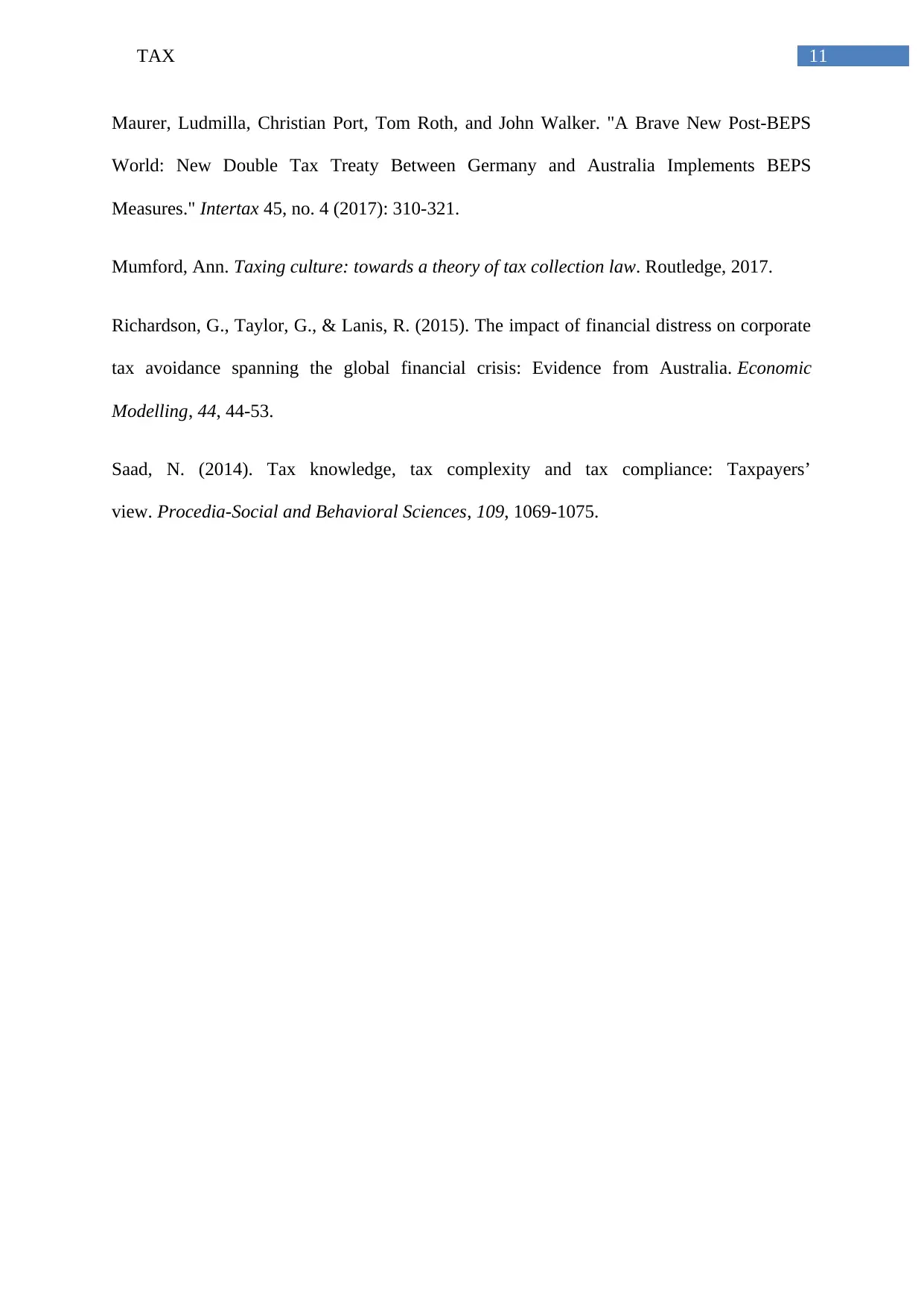
11TAX
Maurer, Ludmilla, Christian Port, Tom Roth, and John Walker. "A Brave New Post-BEPS
World: New Double Tax Treaty Between Germany and Australia Implements BEPS
Measures." Intertax 45, no. 4 (2017): 310-321.
Mumford, Ann. Taxing culture: towards a theory of tax collection law. Routledge, 2017.
Richardson, G., Taylor, G., & Lanis, R. (2015). The impact of financial distress on corporate
tax avoidance spanning the global financial crisis: Evidence from Australia. Economic
Modelling, 44, 44-53.
Saad, N. (2014). Tax knowledge, tax complexity and tax compliance: Taxpayers’
view. Procedia-Social and Behavioral Sciences, 109, 1069-1075.
Maurer, Ludmilla, Christian Port, Tom Roth, and John Walker. "A Brave New Post-BEPS
World: New Double Tax Treaty Between Germany and Australia Implements BEPS
Measures." Intertax 45, no. 4 (2017): 310-321.
Mumford, Ann. Taxing culture: towards a theory of tax collection law. Routledge, 2017.
Richardson, G., Taylor, G., & Lanis, R. (2015). The impact of financial distress on corporate
tax avoidance spanning the global financial crisis: Evidence from Australia. Economic
Modelling, 44, 44-53.
Saad, N. (2014). Tax knowledge, tax complexity and tax compliance: Taxpayers’
view. Procedia-Social and Behavioral Sciences, 109, 1069-1075.
⊘ This is a preview!⊘
Do you want full access?
Subscribe today to unlock all pages.

Trusted by 1+ million students worldwide
1 out of 14
Related Documents
Your All-in-One AI-Powered Toolkit for Academic Success.
+13062052269
info@desklib.com
Available 24*7 on WhatsApp / Email
![[object Object]](/_next/static/media/star-bottom.7253800d.svg)
Unlock your academic potential
Copyright © 2020–2025 A2Z Services. All Rights Reserved. Developed and managed by ZUCOL.





